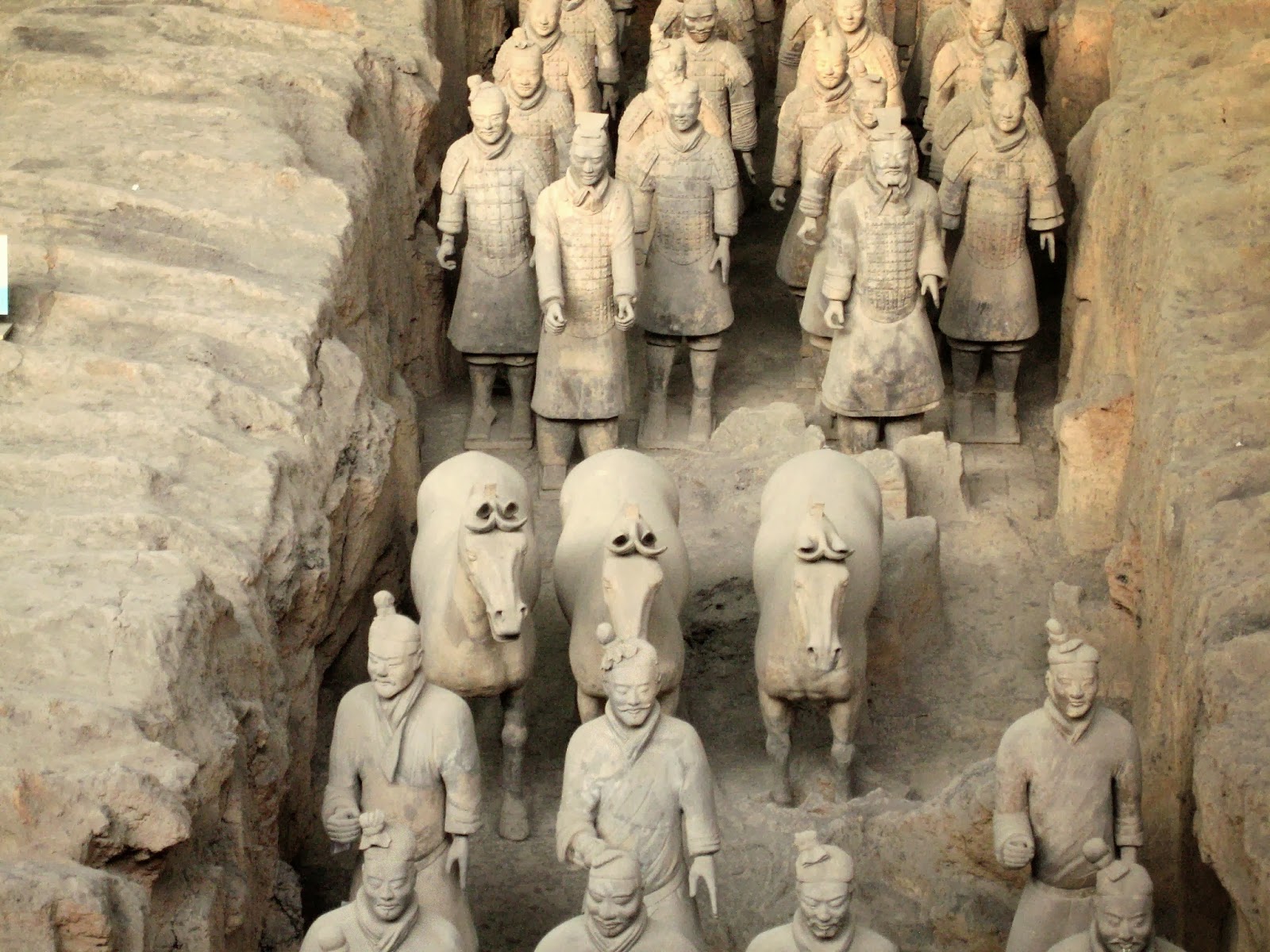Day 5 - Thurs. Jan. 2: We started out by visiting the Terracotta Army Museum and
Qin Shi Huangdi’s Tomb located outside the city of Xi'an. This is one of those
amazing sites that must be seen to be fully appreciated. It’s so impressive and
overwhelming that it’s hard to imagine what it must have been like intact over
2,200 years ago.
Terracotta Army - Pit 1
Terracotta Army - Pit 1
Terracotta Army - Pit 1
Terracotta Army - Pit 2
Terracotta Army - Pit 3
The terracotta
army, however, is just one part of a complex necropolis that is larger than the
Great Pyramid in Egypt. Qin Shi Huangdi (259 – 210 BC) enlisted 700,000
people over 36 years in the construction of his tomb complex, which lies a mile
west of the three pits. The unexcavated mausoleum is said to include an inner
city, an outer city, and a gem-studded underground imperial palace. In addition to a grand tomb that housed
Emperor Qin Shi’s bronze coffin, the complex is also believed to contain 48
tombs for concubines, who were buried alive, a fate also reserved for workers
to prevent the location and design from becoming known.
Statue of Qin Shi Huangdi
Our English-speaking guide, Peter, accompanied us on a tour
of both sites, after which we departed for our next destination, the Banpo Neolithic Village
Museum. We began our visit after a lunch of regional cuisine at a restaurant
just next to the museum, which gets its name from the remains of Banpo village,
located east of X’ian. The Banpo period (4800 – 3600 BC), part of the
matriarchal Yangshao culture that lasted from around 5000 – 2800 BC, saw the
dawn of China’s painted pottery tradition. The village remains were discovered
in 1953. About 500 late Neolithic people inhabited the village beginning around
4500 BC. Remains include over 40 houses, over 200 cellars, and 6 kilns. We
visited for a little over an hour.
Model of Banpo village houses
Returning
to Xi'an, we stopped to visit the Great Wild Goose (Dayan) Pagoda and the Da Ci’en
(Mercy and Kindness) Temple complex that surrounds it. Originally built in 648 by Tang Emperor Gao Zong, the 64-meter pagoda offers a splendid view of
the city. Just outside the park stands a statue of Xuanzang, the monk who journeyed
for 17 years to India and returned with bundles of Buddhist sutras and relics.
Together with 50 workers, he translated the scriptures from Sanskrit into
Chinese, totaling 1,335 volumes, and had the pagoda built to store them. This
heralded a new era in the history of translation.
Great Wild Goose Pagoda (Dayan Ta)
Great Wild Goose Pagoda (Dayan Ta)
The Great Wild
Goose Pagoda derives its name from legend. According to ancient stories of
Buddhists, there were two branches, for one of which eating meat was not a
taboo. One day, they couldn't find meat to buy. Upon seeing a group of big wild
geese flying by, a monk said to himself, “Today we have no meat. I hope the
merciful Bodhisattva will give us some.” At that very moment, the leading wild
goose broke its wings and fell to the ground. All the monks were startled and
believed that Bodhisattva showed his spirit to order them to be more pious.
They established a pagoda where the wild goose fell and stopped eating meat.
Hence its name.
View of Da Ci’en and the fountain from the Great Wild Goose Pagaoda
Da Ci’en (Temple of Mercy and Kindness)
Da Ci’en (Temple of Mercy and Kindness)
Unfortunately,
we missed the nightly musical water show at the giant fountain just north of
the pagoda. Then we strolled the nearby market area before returning to the
Muslim Quarter for some evening snacks. Really loving the city of Xi'an!
Candy-makers in a Muslim Quarter market
After the goo is pulled, it is mixed with chopped nuts and other ingredients and pounded
Click
on the following links for more information about







_02.jpg)
_07.jpg)



No comments:
Post a Comment